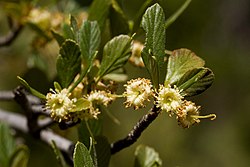Biology:Cercocarpus breviflorus
| Desert mountain mahogany | |
|---|---|

| |
| Scientific classification | |
| Kingdom: | Plantae |
| Clade: | Tracheophytes |
| Clade: | Angiosperms |
| Clade: | Eudicots |
| Clade: | Rosids |
| Order: | Rosales |
| Family: | Rosaceae |
| Genus: | Cercocarpus |
| Species: | C. breviflorus
|
| Binomial name | |
| Cercocarpus breviflorus A.Gray 1853
| |

| |
| Synonyms[1] | |
| |
Cercocarpus breviflorus, commonly known as desert mountain mahogany or hairy mountain mahogany, is a species of plant in the rose family, native to northern Mexico and the southwestern United States.
Description
Cercocarpus breviflorus is an evergreen tree or large shrub growing to about 5 metres (16 ft) tall, often with several branches springing from the base. The small leaves are oblong to oblanceolate, up to 2 cm (1 in) long, pubescent and entire apart from a few weak teeth near the apex. They are fasciculate, with groups of two to four leaves forming small tufts separated by lengths of bare twig. The yellowish-green tubed flowers are inconspicuous and grow from the axils of the leaves. The fruits are achenes with twisted, hairy, elongated and persistent styles, looking like long narrow feathers.[2]
Distribution and habitat
Hairy mountain mahogany occurs in mountainous parts of the southwestern United States (Texas , New Mexico, Arizona) and northern Mexico (from Sonora to Tamaulipas, south as far as Querétaro), on both limestone and igneous rock.[3][2]
Ecology
Hairy mountain mahogany grows at moderately high elevations, often in the company of pinyon pine (Pinus edulis), alligator juniper (Juniperus deppeana), one-seed juniper (Juniperus monosperma), cliff fendlerbush (Fendlera rupicola), antelope bitterbrush (Purshia tridentata), wavyleaf oak (Quercus x undulata), and skunkbush sumac (Rhus trilobata).[4] The branches are often heavily encrusted with lichens.
References
- ↑ The Plant List, Cercocarpus montanus var. paucidentatus (S.Watson) F.L.Martin
- ↑ 2.0 2.1 Flora of North America, Cercocarpus breviflorus A. Gray, 1853. Eastern mountain-mahogany
- ↑ "Hairy Cercocarpus, Hairy Mountain Mahogany, Wright Mountain Mahogany, Shaggy Mountain Mahogany". Texas native plants. https://aggie-horticulture.tamu.edu/ornamentals/natives/CERCOCARPUSBREVIFLORUS.HTM. Retrieved 2015-01-17.
- ↑ Tesky, Julie L. 1993 US Forest Service: Fendlera rupicola
Wikidata ☰ Q20686183 entry
 |

